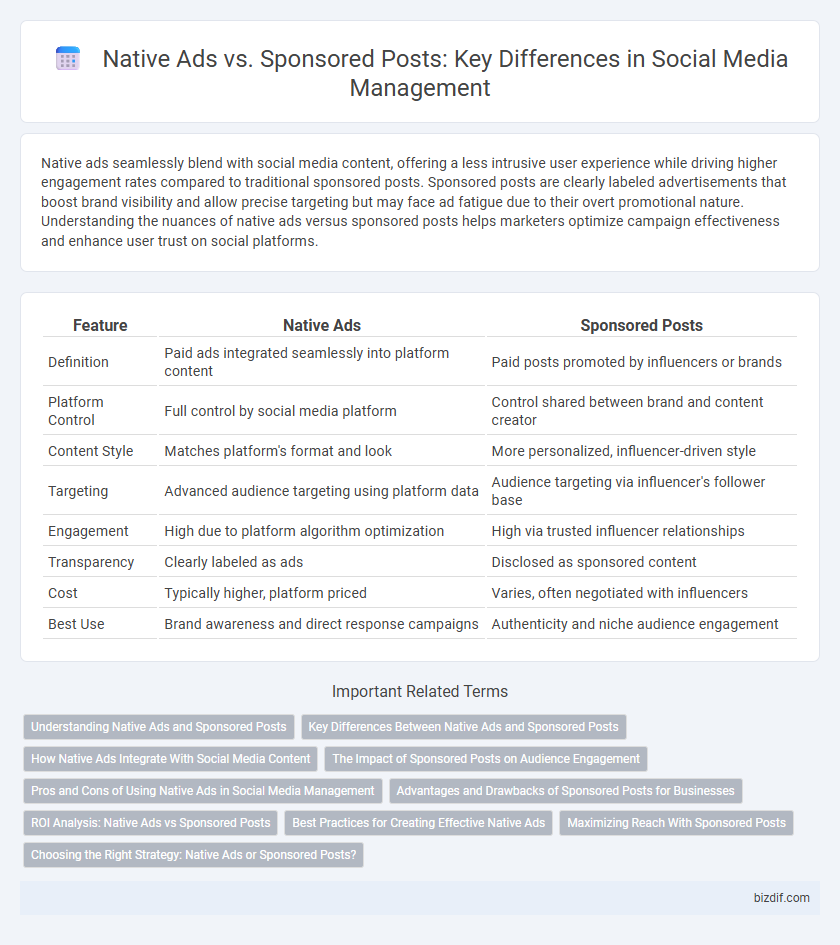Native ads seamlessly blend with social media content, offering a less intrusive user experience while driving higher engagement rates compared to traditional sponsored posts. Sponsored posts are clearly labeled advertisements that boost brand visibility and allow precise targeting but may face ad fatigue due to their overt promotional nature. Understanding the nuances of native ads versus sponsored posts helps marketers optimize campaign effectiveness and enhance user trust on social platforms.
Table of Comparison
| Feature | Native Ads | Sponsored Posts |
|---|---|---|
| Definition | Paid ads integrated seamlessly into platform content | Paid posts promoted by influencers or brands |
| Platform Control | Full control by social media platform | Control shared between brand and content creator |
| Content Style | Matches platform's format and look | More personalized, influencer-driven style |
| Targeting | Advanced audience targeting using platform data | Audience targeting via influencer's follower base |
| Engagement | High due to platform algorithm optimization | High via trusted influencer relationships |
| Transparency | Clearly labeled as ads | Disclosed as sponsored content |
| Cost | Typically higher, platform priced | Varies, often negotiated with influencers |
| Best Use | Brand awareness and direct response campaigns | Authenticity and niche audience engagement |
Understanding Native Ads and Sponsored Posts
Native ads seamlessly blend with organic content, matching the platform's style and providing a non-disruptive user experience to enhance engagement. Sponsored posts are explicitly marked advertisements on social media, designed to reach specific audiences through targeted promotion and paid placements. Both formats leverage platform-specific algorithms to maximize visibility, but native ads prioritize subtlety while sponsored posts emphasize clear brand messaging.
Key Differences Between Native Ads and Sponsored Posts
Native ads seamlessly blend with platform content, matching the form and function of the user experience to enhance engagement without disrupting the audience. Sponsored posts are more overtly promotional, clearly marked as advertising and often appearing as distinct from organic content to maintain transparency. The key difference lies in native ads' subtle integration versus sponsored posts' explicit sponsorship identification, influencing user perception and ad effectiveness.
How Native Ads Integrate With Social Media Content
Native ads seamlessly blend with social media content by matching the platform's format, style, and tone, enhancing user engagement without disrupting the browsing experience. These ads appear as natural parts of the feed, leveraging contextual relevance and personalized targeting to increase click-through rates. Unlike sponsored posts, which are explicitly labeled as advertisements, native ads prioritize subtlety to build trust and improve brand perception within social channels.
The Impact of Sponsored Posts on Audience Engagement
Sponsored posts significantly boost audience engagement by appearing seamlessly within users' social media feeds, fostering higher trust and interaction compared to traditional ads. These posts leverage platform-specific formats and user behavior, resulting in increased likes, shares, and comments that enhance brand visibility. Brands employing sponsored posts report up to 30% higher engagement rates, driving better ROI in social media marketing campaigns.
Pros and Cons of Using Native Ads in Social Media Management
Native ads in social media management offer high user engagement by seamlessly blending with platform content, enhancing brand trust and reducing ad fatigue. However, they require careful design to avoid misleading audiences and can be costlier than other ad formats due to the need for quality content creation. Brands must balance authenticity and promotional messaging to maximize native ad effectiveness while maintaining transparency.
Advantages and Drawbacks of Sponsored Posts for Businesses
Sponsored posts offer businesses targeted reach by blending promotional content seamlessly within users' social feeds, enhancing engagement through personalized messaging. However, they may face challenges such as higher costs and the potential for reduced authenticity if audiences perceive the content as overly commercial. Despite these drawbacks, sponsored posts provide measurable ROI through advanced analytics tools, enabling precise tracking of campaign performance and audience interactions.
ROI Analysis: Native Ads vs Sponsored Posts
Native ads typically deliver higher ROI due to their seamless integration with platform content, increasing user engagement and reducing ad fatigue. Sponsored posts can boost brand visibility but often show lower conversion rates and higher cost-per-acquisition compared to native ads. Analyzing metrics such as click-through rates, engagement time, and conversion tracking highlights native ads as more efficient for maximizing social media advertising ROI.
Best Practices for Creating Effective Native Ads
Native ads perform best when designed to blend seamlessly with the platform's content, utilizing native formats and matching the visual style to avoid disrupting user experience. Crafting compelling headlines and incorporating clear calls-to-action enhances engagement and drives click-through rates. Leveraging precise audience targeting and A/B testing different creative elements ensures the ad resonates effectively, maximizing conversion and return on ad spend.
Maximizing Reach With Sponsored Posts
Sponsored posts maximize reach by leveraging precise audience targeting and platform-specific algorithms to boost visibility beyond organic followers. Unlike native ads that blend with content formats, sponsored posts appear more prominently in users' feeds, increasing engagement rates and click-throughs. Utilizing detailed analytics, marketers can optimize sponsored post campaigns in real time to ensure maximum reach and return on investment across social media channels.
Choosing the Right Strategy: Native Ads or Sponsored Posts?
Choosing between native ads and sponsored posts depends on targeting goals and audience engagement preferences. Native ads seamlessly integrate with platform content, enhancing user experience and boosting brand awareness, while sponsored posts offer clearer promotional intent and stronger calls to action for direct conversions. Evaluating campaign objectives, platform algorithms, and audience behavior ensures an effective social media management strategy that maximizes ROI.
Native ads vs Sponsored posts Infographic

 bizdif.com
bizdif.com